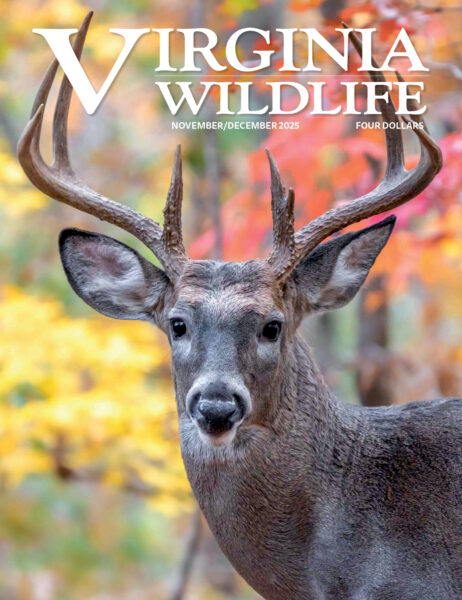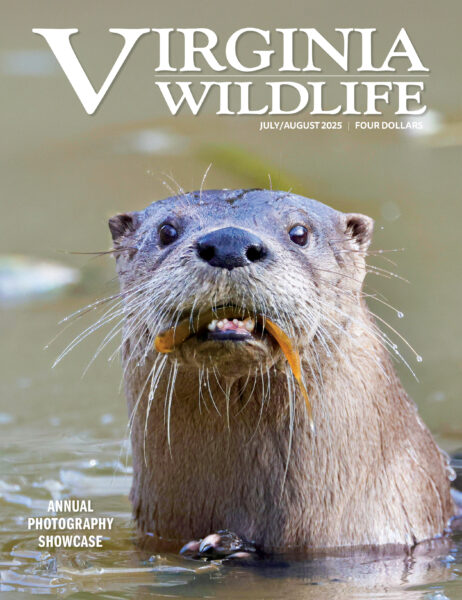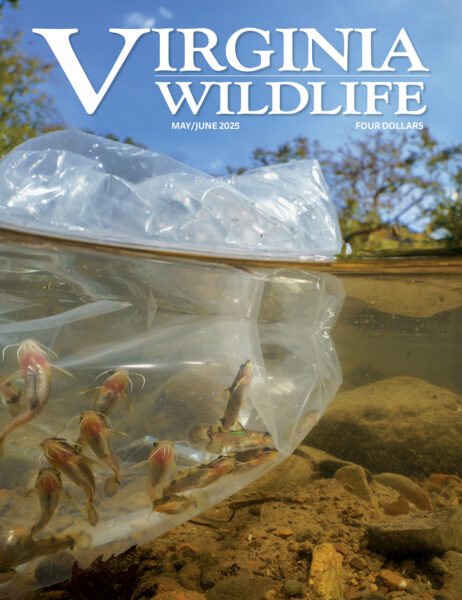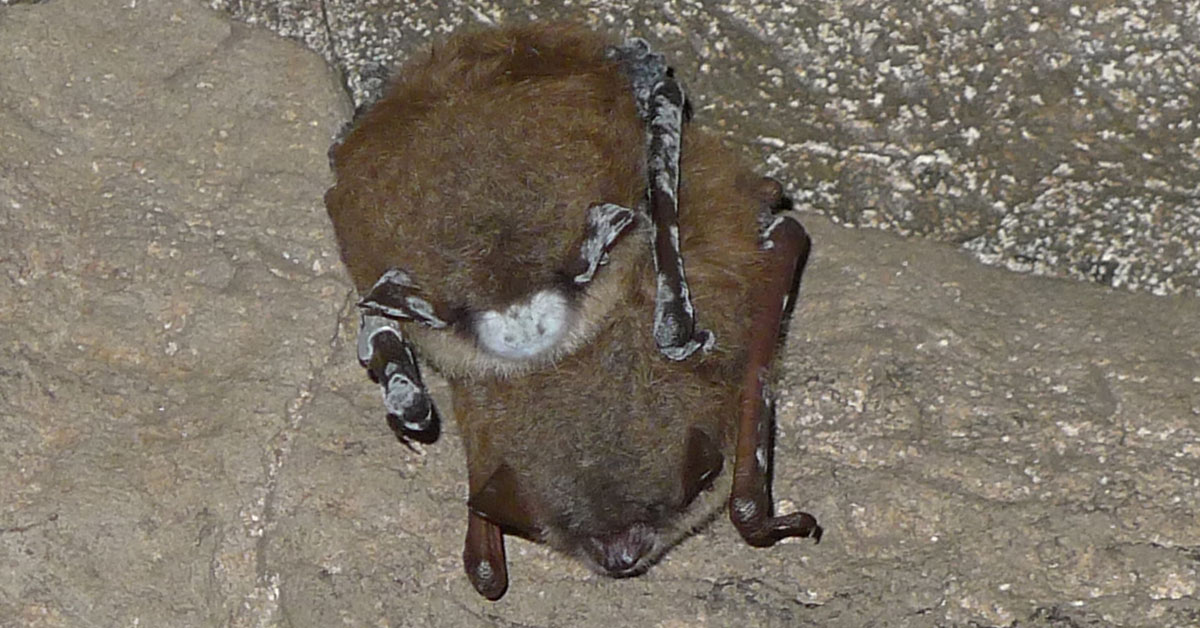
White-nose syndrome, as seen on the muzzle and wings of this little brown bat, is an insidious disease killing thousands of bats.
By Rick Reynolds/DWR
Photos by Rick Reynolds/DWR
It’s been a little more than 10 years since white-nose syndrome (WNS), a disease that affects hibernating bats, showed up in Virginia in 2009. In those 10 years, studies have shown that WNS has had a significant impact on some of Virginia’s bat species, while other species have escaped its wrath. WNS is still a threat to some bat species in Virginia, but after a decade, biologists have a better understanding of its effects and some innovative ideas to battle it.
In order to understand how WNS, which is caused by the fungus Pseudogymnoascus destructans, or Pd for short, affects bats, keep in mind that bats are mammals—they bear their young live, feed their young milk, and grow hair. What makes bats unique is that they are the only mammal that can sustain flight and for that reason are put into their own order of mammals called Chiroptera, meaning “hand wing.” This is understandable when you look at a bats wing and see that it is mostly a forearm and hand.
One of the largest orders of mammals with more than 1,200 species, bats make up 1/5 of the world’s mammals. Despite the large diversity of bats around the world, only 17 species of bats have been documented in Virginia. While the majority of the world’s bats are fruit- or nectar-eating, all of Virginia’s bats are insect eaters. They have adapted to the loss of food during the winter months by hibernating from late fall to early spring.
During hibernation, Virginia’s bats roost in caves, hollow trees, or sometimes human dwellings. Their winter roosts must have consistent temperatures between the upper 30 and upper 40 degrees with high humidity. Before bats go into hibernation in late fall, they spend their final weeks outdoors eating and fattening up for the winter. When they go into hibernation, bats reduce their body temperature to the ambient temperature of their roost and lower their metabolic functions in order to save energy to make it through the winter.
Bats can live 20-plus years in the wild, but they typically produce only one young per year. This makes it extremely difficult for a species to recovery from a dramatic decline.
About White-Nose Syndrome
Because the fungus causing WNS is most notable on the muzzle of bats, the term white-nose syndrome was coined. Pd is a cold-loving fungus that grows best at temperatures between 40-50 degrees and high humidity levels—the same temperature gradient and humidity levels in which the majority of Virginia’s bats prefer to hibernate.
The fungus grows into the exposed dermis (skin) of the bat’s tail membrane, wings, ears, and muzzle. You can imagine what an irritant a fungus growing into your skin must be. This alone would cause you to wake up. The fungal growth also disrupts the bat’s water balance, causing dehydration and electrolyte imbalances.
Combined together these issues cause bats to wake up twice as often as they normally would over the winter months. Remember, bats “fattened up” in the fall knowing they would wake up occasionally through the winter, because who can hang in one position month after month, but they were not expecting to wake up twice as often as normal.
The added arousals use up the bats’ stored fats as they raise their body temperature back to normal, making them hungry. They then use additional energy flying outside to try to find insects to eat. In the middle of winter, flying insects are a rarity. So it is a death by a thousand cuts that has caused significant declines in several species of bats in Virginia and throughout their range.
What About Virginia’s Bats?
DWR and partners have been conducting bat surveys since the early 1980s. Hibernacula, or cave, surveys are the traditional method that biologists use to monitor population changes in hibernating bats. Bats that over-winter in caves typically show strong site fidelity to both the cave and even the passages in the cave. Some species of bats cluster in large groups hanging out in the open on the walls and ceilings of caves, making counting them a fairly simple task. Several species that either cluster in large groups or roost in the open include the little brown, Indiana, Virginia big-eared, and tri-colored bats.
We expected to find the little brown bat in most of the caves we surveyed, and they made up the majority of the bats we would count with numbers greater than 5,000 at one of our sites. With the onset of WNS, we saw those numbers decline. By 2013 little brown bat numbers had declined by greater than 95% with some sites completely extirpated (Figure 1). Today the decline has reached a shocking 99% of the historic records.

Figure 1. Hibernacula counts for little brown bats at major caves in Virginia.
If there is a bright spot for this species, we believe the decline has stabilized and we have found a couple new sites with several hundred little browns each and these sites appear to be stable.
Listed as federally and state- endangered, the Indiana bat was declining before WNS, mostly due to disturbances at hibernacula. Progress was being made to protect their winter roosts, and populations were starting to rebound pre-WNS. While the Indiana bat has declined by only 40% in Virginia since the onset of WNS, their populations are still down by about 80% compared to historic numbers 50 years ago.
Tri-colored bats are one of the smallest of Virginia’s bats and found in more caves than any other species of bat in Virginia. A wide tolerance for cave temperatures and humidity levels allows them to adapt to a variety of cave environments. That said, we have still lost close to 95% of our winter roosting populations compared to pre-WNS counts.
This is a species that typically doesn’t cluster in large groups, but can be found throughout a cave in small numbers. Surprisingly, in the early stages of WNS infection, we would find large numbers of tri-colored and little brown bats clustered and flying around inside the entrances, away from their typical roosts. These were obviously bats infected with WNS, wanting to leave the cave to forage because their fat reserves were depleted.
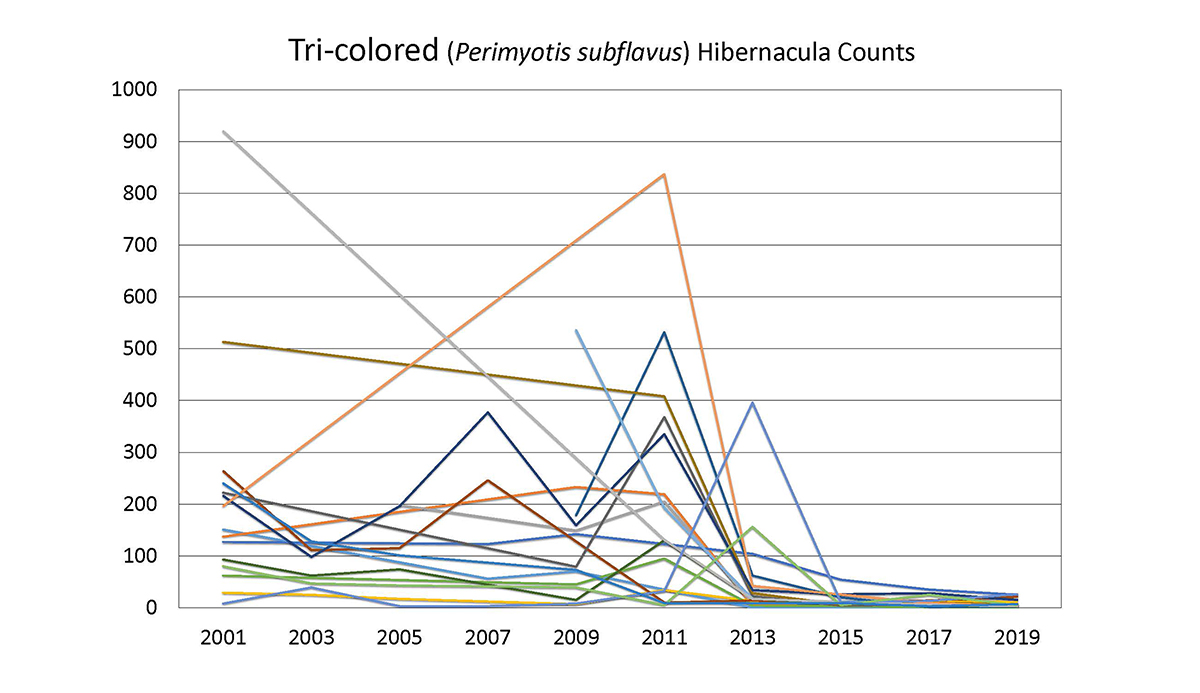
Figure 2. In this graph, note the spike in numbers around 2011. This is the period where large numbers of tri-colored bats were found clustered just inside cave entrances. By 2013, these clusters were no longer observed and population numbers declined by almost 95%.
While the overall numbers of tri-colored bats have declined significantly, we still find small numbers of individuals in many of the caves we survey. We are hoping that these are survivors of WNS and that they can maintain the species’ existence.
Because Virginia big-eared bats are one of the rarest bats in the state, found in only a few counties in the mountain regions, there was great concern that WNS could cause the species’ extinction. While Pd spores have been found on Virginia big-eared bats, they don’t develop into the fungus causing WNS. We are lucky that this species appears to be “immune” from WNS, but we still have an uphill battle due to their historically small numbers.
The northern long-eared bat is a cave bat that is difficult to find due to their behavior of roosting in tight cracks, under rocks, and in high crevices. However, during the summer this was one of the most common species captured in our mist-nets in the mountain regions of the state.
To determine the effects of WNS on northern long-eared bats we went back to sites where we had good capture rates pre-WNS and re-sampled using the same number and position of nets and running them for the same duration. Between 2011 and 2013 our capture rate declined significantly, just over 95%.
We also looked at different aspects of the demographics (characteristics of populations) between the pre- and post-WNS time periods. What we found was juvenile recruitment had declined by greater than 75%, suggesting that remaining populations are not viable and that the presence of northern long-eared bats in western Virginia is tenuous.
In addition to monitoring population changes at winter hibernacula, we also used mist-nets and harp traps to capture bats and documented changes in capture rates during the fall swarm period, when cave bats congregate around cave entrances to “fatten up” on insects in the fall before going into hibernation. This is also the reproductive period. For our three major species impacted by WNS (little brown, northern long-eared, and tri-colored bats) we noted significant declines in capture rates similar to the declines found during our hibernacula surveys, helping us confirm the rate of decline observed at hibernacula.
So while the picture for the little brown, northern long-eared, Indiana, and tri-colored bats doesn’t look good at this point in time, there are several cave bats—big brown, gray, small footed, and Virginia big-eared—that have not been significantly impacted by WNS. It is not certain exactly why, as they have all been found to carry the spores of the disease and some individuals have been found with the disease.
With a couple of these species, researchers have shown that other fungi and bacteria naturally occurring on these species prohibits the Pd spores from developing into the WNS fungus. It is also thought that some of these species may use other habitats (rocky talus slopes, crevices in cliffs, etc.) to over-winter and thus avoid being exposed to WNS.
What Can We Do?
The big question is what can and are we doing to address this problem?
When white-nose syndrome was first discovered in New York in 2006-07, scientists, state and federal wildlife agencies, and conservation groups quickly united and formed the White-nose Syndrome Response Team. This USFWS-led team developed the National White-nose Syndrome Plan with five working groups: Disease Management, Surveillance and Diagnostics, Communications and Outreach, Conservation and Recovery, and Data Management. Each working group has developed goals and objectives with an action plan. The National Plan and the Action Plans for each working group can be found at https://www.whitenosesyndrome.org/.
The Disease Management Working Group focuses on actions to slow the spread of the disease and develops intervention strategies to treat and protect susceptible bat species. This task definitely takes a village, and many government and academic institutions are taking a multi-faceted approach to address the disease. Examples of some of the different approaches include:
- Biological: Through the use of probiotics, antifungal bacteria, and beneficial fungi growing on bat wings, researchers are looking at ways to stimulate beneficial microorganisms that either attack or compete with Pd to limit growth or kill the fungus.
- Chemical: Volatile Organic Compounds, such as Rhodococcus rhodochrous, have antifungal properties that have been shown to inhibit the growth of Pd. A favorable aspect of these compounds is that they don’t need to be applied directly to bats, but can be applied to the environment (hibernacula) instead (typically in a gaseous form).
- Immunological: Perhaps the most difficult area of research is the development and implementation of a vaccine. Currently there are no approved vaccines for any fungal disease in the United States. If a vaccine could be developed, then the challenge is how to deliver the vaccine to such a highly mobile animal.
- Genetic Manipulation: On the cutting edge of technology is the study of gene manipulation. By “turning off” Pd genes that cause harm to bats, we may be able to reduce symptoms or alter the Pd gene expression.
- Mechanical: One approach focuses on changing the environment that Pd lives in. By changing the temperature and humidity levels in hibernacula, we can make conditions less favorable for Pd to survive and more favorable to bats.
Positive Steps for Virginia’s Bats
In Virginia, we have followed the guidance of the National Plan with a focus on surveillance, conservation and recovery, and outreach as well as supporting researchers studying treatments for the disease. Our initial efforts focused on assessing the impacts of WNS on species and populations and identifying the locations of surviving populations so we can protect and manage them.
We are also looking at ways to improve the health of bats that appear to be surviving the fungus year after year. In northern states where the fungus first arrived, they found that little brown bats going into hibernation post-WNS are fatter than those entering hibernation pre-WNS. Perhaps a behavioral response to WNS, bats having additional fat going into hibernation should have a better chance of surviving the added arousal periods that WNS causes.
Researchers at Bat Conservation International are studying the effects of creating “bat buffets” as a means of fattening up bats before they go into hibernation by concentrating insects near hibernacula. Their approach involves hanging UV lights high in trees in order to attract and concentrate insects and maximize foraging activity for bats. Preliminary results look promising, but this is still in the early stages of testing.
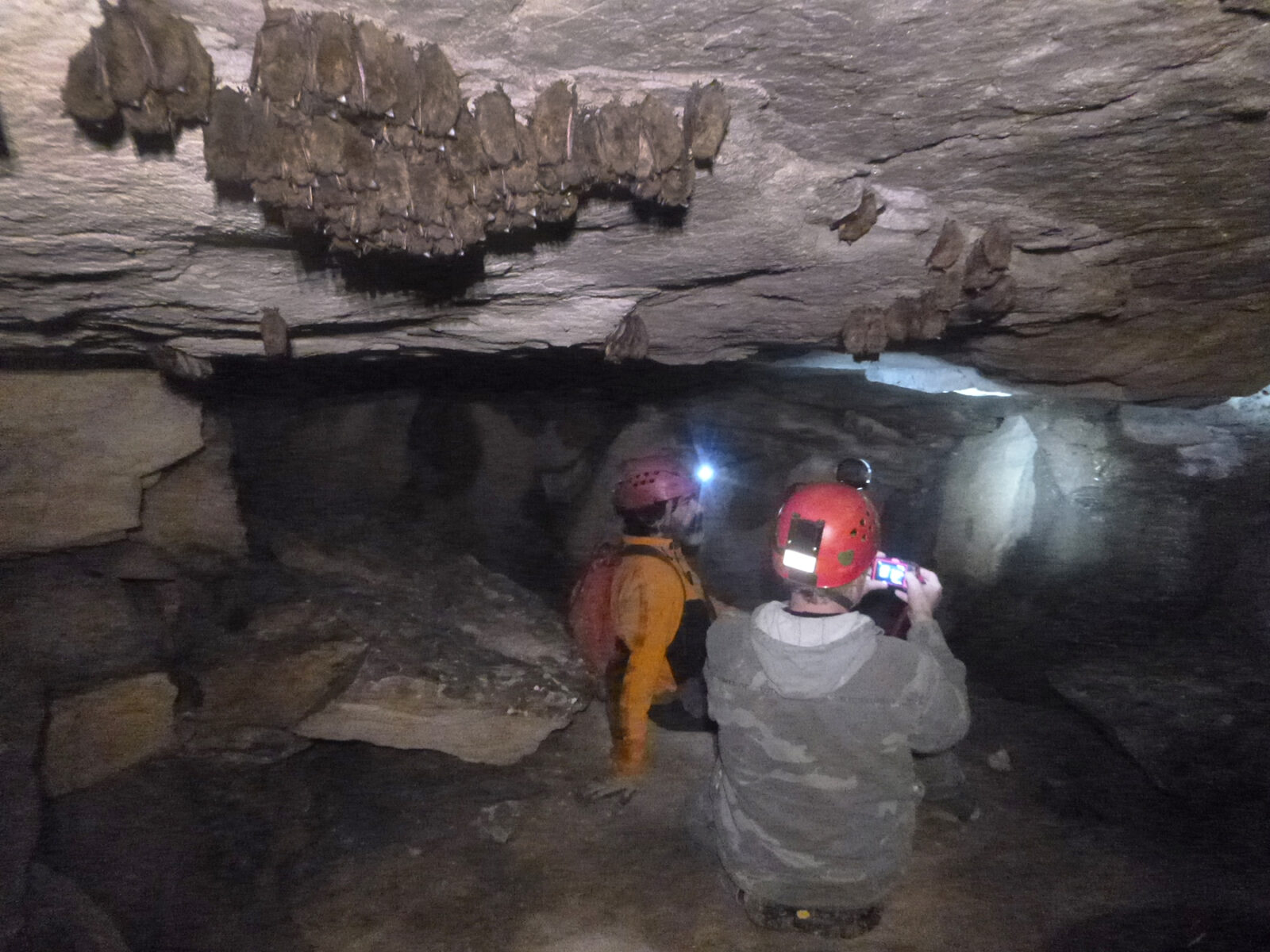
Steve Thomas, National Park Service, and Tom Malabad, Dept. of Conservation and Recreation – Natural Heritage Program, count and photograph little brown bats in a southwestern Virginia cave.
In addition to identifying and protecting the habitats that our remaining bat populations utilize, we are interested in knowing the secondary effects of WNS on reproduction and survivorship to help us understand whether or not our bat populations have the capability to recover from this disease.
Before WNS arrived in Virginia, researchers at the BioDiversity Research Institute were studying the effects of mercury on bat populations in the South River. They identified several large little brown bat maternity roosts, all with populations over 1,000 individuals. After the initial onset of WNS, we went back to several of these roosts to document both changes in population numbers and in reproductive condition (percentage of reproductively active females).
We started out monitoring six maternity roosts in 2011 and within a year’s time we lost four of the six roosts. We continued to monitor the two remaining sites and in 2014 found an additional site to add to our sampling. At each site we mist-netted bats once in mid-spring, pre-pup season, and once in mid-summer, post-pup season. Each bat was fitted with a unique alpha-numeric band allowing us the opportunity to follow individual survivorship over time.
In our 2019 survey we found 85% of the adult females to be in reproductive condition. Of the 23 recaptures, one was a minimum of 8 years of age, two of 7 years of age, seven of 6 years of age, and the remaining were 5 years of age or younger. This showed us that of the adult females surviving WNS, the majority are still reproducing with proof of longevity in recaptures. This is good news for our remaining little brown bat populations, but it will be a long road to recovery for a species with low productivity.
The road ahead for our bats exposed to WNS appears more promising for some species than others. Of our bats that have been impacted by WNS, the little brown, northern long-eared, and tri-colored bats have suffered significant population declines. The northern long-eared looks to be the most tenuous with high population declines and recruitment of juvenile bats extremely low.
Little brown bats have declined significantly as well, but with a ray of hope as maternity colonies continue producing young and individuals surviving multiple years of infection. While tri-colored bats declined significantly as well, the fact we still find them in the majority of caves we survey is encouraging, suggesting their populations may be stabilizing. WNS appears to have less of an impact on Indiana bats, but they are still vulnerable to other stressors and only time will tell the direction this species takes.
Despite these impacts, we are still hopeful that through our strong collaborative effort, the White-nose Syndrome Response Team, we will be able to turn this disease around and keep Virginia’s bats thriving.
Rick Reynolds has worked as a non-game biologist with DWR for more than 30 years with a focus on threatened and endangered bats.

This article originally appeared in Virginia Wildlife Magazine.
For more information-packed articles and award-winning images, subscribe today!
Learn More & Subscribe


